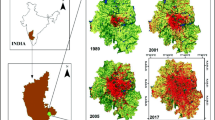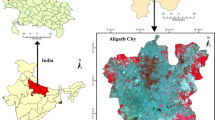Abstract
The current work attempts to understand the spatiotemporal patterns of the urban heat phenomenon (UHP) and its relationship with the transformation of land-use/land-cover in Chandannagar city of India in four different phases, e.g., in pre-monsoon and post-monsoon of 1988 and 2020 based on Landsat satellite data. To investigate the city’s thermal and environmental conditions in a better way, UHP and non-UHP areas are identified separately. Moreover, multiple linear regression (MLR) and simple linear regression (SLR) models are used to envisage the predictability of land surface temperature (LST) by various remote sensing indices and UHP by built-up areas. The results assert that mean LST in both pre-monsoon and post-monsoon from 1988 to 2020 has increased at the rate of 0.11°C and 0.1°C each year, respectively. Built-up areas, UHP areas and mean LST linearly increase in those directions from the city centre where vegetation cover and non-UHP areas decrease rapidly. Moreover, growth of multiple UHP areas, the highest increase in UHP intensity and good applicability of MLR and SLR models are observed in pre-monsoon than post-monsoon. Therefore the information regarding urban thermal environments is expected to be very useful for policymakers and urban planners in adopting suitable mitigation measures against unplanned urbanisation leading to UHP effects.
















Similar content being viewed by others
References
Artis D A and Carnahan W H 1982 Survey of emissivity variability in thermography of urban areas; Remote Sens. Environ. 12(4) 313–329, https://doi.org/10.1016/0034-4257(82)90043-8.
CoI (Census of India) 2011 District Census Handbook Hugli; https://censusindia.gov.in/nada/index.php/catalog/1351/download/4418/DH_2011_1912_PART_B_DCHB_HUGLI.pdf.
Chandra S, Sharma D and Dubey S K 2018 Linkage of urban expansion and land surface temperature using geospatial techniques for Jaipur City, India; Arab. J. Geosci. 11(2) 31, https://doi.org/10.1007/s12517-017-3357-6.
Foody G M 1992 On the compensation for chance agreement in image classification accuracy assessment; Photogramm. Eng. Remote Sens. 58(10) 1459–1460.
Ghosh S, Chatterjee N D and Dinda S 2019 Relation between urban biophysical composition and dynamics of land surface temperature in the Kolkata Metropolitan Area: A GIS and statistical-based analysis for sustainable planning; Model. Earth Syst. Env. 5(1) 307–329, https://doi.org/10.1007/s40808-018-0535-9.
Grover A and Sing R B 2015 Analysis of urban heat island (UHI) in relation to normalised difference vegetation index (NDVI): A comparative study of Delhi and Mumbai; Environments 2(2) 125–138, https://doi.org/10.3390/environments2020125.
Guha S, Govil H, Dey A and Gill N 2018 Analytical study of land surface temperature with NDVI and NDBI using Landsat 8 OLI and TIRS data in Florence and Naples City, Italy; Europ. J. Remote Sens. 51(1) 667–678, https://doi.org/10.1080/22797254.2018.1474494.
Guha S and Govil H 2021 An assessment on the relationship between land surface temperature and normalised difference vegetation index; Environ. Dev. Sustain. 23(2) 1944–1963, https://doi.org/10.1007/s10668-020-00657-6.
Halder B, Bandyopadhyay J and Banik P 2021 Monitoring the effect of urban development on urban heat island based on remote sensing and geo-spatial approach in Kolkata and adjacent areas, India; Sust. Cities Soc. 74 103186, https://doi.org/10.1016/j.scs.2021.103186.
Hoque I and Lepcha S K 2019 A geospatial analysis of land use dynamics and its impact on land surface temperature in Siliguri Jalpaiguri development region, West Bengal; Appl. Geomatics 12(2) 163–178, https://doi.org/10.1007/s12518-019-00288-1.
Hulley M E 2012 The urban heat island effect: Causes and potential solutions; In: Metropolitan sustainability: Understanding and improving the urban environment (ed.) Zeman F, Woodhead Publishing, pp. 79–98, ISBN, 978-0-85709-046-1.
Jalan S and Sharma K 2014 Spatio-temporal assessment of land use/land cover dynamics and urban heat island of Jaipur City using satellite data; Int. Arch. Photogramm. Remote Sens, Spatial Inf. Sci. 40(8) 767, https://doi.org/10.5194/isprsarchives-XL-8-767-2014.
Kalnay E and Cai M 2003 Impact of urbanisation and land use change on climate; Nature 423 528–531, https://doi.org/10.1038/nature01675.
Kant Y, Bharath B, Mallick J, Atzberger C and Kerle N 2009 Satellite-based analysis of the role of land use/land cover and vegetation density on surface temperature regime of Delhi, India; J. Ind. Soc. Remote Sens. 13(2) 201–214, https://doi.org/10.1007/s12524-009-0030-x.
Kumari P, Garg V, Kumar R and Kumar V 2021 Impact of urban heat island formation on energy consumption in Delhi; Urban Clim. 36 100763, https://doi.org/10.1016/j.uclim.2020.100763.
Landsat project science office 2002 Landsat 7 Science Data User’s Handbook. http://ltpwww.gsfc.nasa.gov/IAS/handbook/handbook_toc.html, Goddard Space Flight Centre, NASA, Washington, DC.
Li J, Song C, Cao L, Zhu F, Meng X and Wu J 2011 Impacts of landscape structure on surface urban heat islands: A case study of Shanghai, China; Remote Sens. Env. 115(12) 3249–3326, https://doi.org/10.1016/j.rse.2011.07.008.
Liu L and Zhang Y 2011 Urban Heat Island analysis using the landsat data and ASTER data: A case study in Hong Kong; Remote Sens. 3 1535–1552, https://doi.org/10.3390/rs3071535.
Liu X, Zhau Y, Yue W, Li X, Liu Y and Lu D 2020 Spatiotemporal patterns of summer urban heat island in Beijing, China using an improved land surface temperature; J. Cleaner Prod. 257 120529, https://doi.org/10.1016/j.jclepro.2020.120529.
Lu Y, Feng X, Xiao P, Shen C and Sun J 2009 Urban heat island in summer of Nanjing based on TM data; 2009 Joint Urban Remote Sensing Event, pp. 1–5, https://doi.org/10.1109/URS.2009.5137628.
Ma Y, Kuang Y and Huang N 2010 Coupling urbanisation analyses for studying urban thermal environment and its interplay with biophysical parameters based on TM/ETM+ imagery; Int. J. Appl. Earth Obs. Geoinf. 12(2) 110–118, https://doi.org/10.1016/j.jag.2009.12.002.
Mallick J, Kant Y and Bharat B D 2008 Estimation of land surface temperature over Delhi using Landsat-7 ETM+; J. Ind. Geophys. Union 12(3) 131–140.
Mallick J, Rahman A and Sing C K 2013 Modeling urban heat islands in heterogeneous land surface and its correlation with impervious surface area by using night-time ASTER satellite data in highly urbanising city, Delhi, India; Adv. Space Res. 52(4) 131–140, https://doi.org/10.1016/j.asr.2013.04.025.
Mohammad P, Goswami A and Bonafoni S 2019 the impact of the land cover dynamics on surface urban heat island variation in semi-arid cities: A case study in Ahmedabad City, India, using multi-sensor/source data; Sensors 19 3701, https://doi.org/10.3390/s19173701.
Oke T R 1995 The Heat Island of the Urban Boundary Layer. Characteristics, causes and effect; In: Wind climate in cities (ed.) Cermark J E, Netherlands: Kluwer Academic Publishers, pp. 81–107.
Pacheco-Torgal F 2015 Eco-efficient materials for mitigating building cooling needs design, properties and application; In: Introduction to eco-efficient materials for mitigating building cooling needs (eds) Labrincha J A and Granqvist C G, Woodhead Publishing, https://doi.org/10.1016/C2014-0-02697-4.
Pal S and Sk Ziaul 2017 Detection of land use and land cover change and land surface temperature in English Bazar Urban Centre, Egypt; J. Remote Sens. Space Sci. 20(1) 125–145, https://doi.org/10.1016/j.ejrs.2016.11.003.
Pramanik S and Punia M 2020 Land use land cover change and surface urban heat island intensity: Source-sink landscape based study in Delhi, India; Environ. Dev. Sustain. 22(8) 7331–7356, https://doi.org/10.1007/s10668-019-00515-0.
Rahman A, Netzband M, Singh A and Mallick J 2009 An assessment of urban environmental issues using remote sensing and GIS technique an integrated approach: A case study: Delhi, India; Committee for International Cooperation in National Research in Demography, Paris, pp. 181–211.
Sannigrahi S, Bhatt S, Rahmat S, Uniyal B, Banerjee S, Chakraborti S, Jha S, Lahiri S, Santra K and Bhatt A 2018 Analysing the role of biophysical compositions in minimising urban land surface temperature and urban heating; Urban Clim. 24 863–819, https://doi.org/10.1016/j.uclim.2017.10.002.
Saha P, Bandopadhyay S, Kumar C and Mitra C 2020 Multi-approach synergic investigation between land surface temperature and land-use land-cover; J. Earth Syst. Sci. 129 74, https://doi.org/10.1007/s12040-020-1342-z.
Sharma R, Gosh A and Joshi P K 2013 Spatio-temporal footprints of urbanisation in Surat, the Diamond City of India (1990–2009); Environ. Monit. Assess. 185 3313–3325, https://doi.org/10.1007/s10661-012-2792-9.
Sharma R and Joshi P K 2014 Identifying seasonal heat islands in urban settings of Delhi (India) using remotely sensed data – An anomaly based approach; Urban Clim. 9 19–34, https://doi.org/10.1016/j.uclim.2014.05.003.
Siddique G, Ghosh S and Roy A 2020 Assessment of urban expansion and associated spatial transformation of chandannagar city, West Bengal; Space Culture India 7(4) 109–121, https://doi.org/10.20896/saci.v7i4.533.
Singh P, Kikon N and Verma P 2017 Impact of Land use change and urbanisation on urban heat island in Lucknow City, Central India: A remote sensing based estimate; Sust. Cities Soc. 32 100–114, https://doi.org/10.1016/j.scs.2017.02.018.
Siqi J and Yuhong W 2020 Effects of land use and land cover pattern on urban temperature variations: A case study in Hong Kong; Urban Clim. 34 100693, https://doi.org/10.1016/j.uclim.2020.100693.
Sobrino J A, Jimenez-Munoz J C and Paloni L 2004 Land surface temperature retrieval from LANDSAT TM 5; Remote Sens. Environ. 90(4) 434–440, https://doi.org/10.1016/j.rse.2004.02.003.
Sultana S and Satyanarayana A N V 2018 Urban heat island intensity during winter over metropolitan cities of India using remote-sensing techniques: Impact of urbanisation; Int. J. Remote Sens. 39(20) 6692–6730, https://doi.org/10.1080/01431161.2018.1466072.
Sultana S and Satyanarayana A N V 2020 Assessment of urbanisation and urban heat island intensities using landsat imageries during 2000–2018 over a sub-tropical Indian city; Sustain. Cities Soc. 52 101846, https://doi.org/10.1016/j.scs.2019.101846.
Sun Q, Wu Z and Tan J 2011 The relationship between land surface temperature and land use/land cover in Guangzhou, China; Environ. Earth Sci. 65 1687–1694, https://doi.org/10.1007/s12665-011-1145-2.
Townshend J R G and Justice C O 1986 Analysis of the dynamics of African vegetation using the normalised difference vegetation index; Int. J. Remote Sens. 7(11) 1435–1445, https://doi.org/10.1080/01431168608948946.
United Nations 2018 The world’s cities in 2018 – data booklet. Department of Economics and Social Affairs, Population Division; https://www.un.org/en/events/citiesday/assets/pdf/the_worlds_cities_in_2018_data_booklet.pdf.
United Nations 2019 World population prospects: highlights. Department of Economics and Social Affairs, Population Division; https://population.un.org/wpp/Publications/Files/WPP2019_Highlights.pdf.
Voogt J A and Oke T R 2003 Thermal remote sensing of urban climates; Remote Sens. Environ. 86(3) 370–384, https://doi.org/10.1016/S0034-4257(03)00079-8.
Wang F, Qin Z, Song C, Tu L, Karnieli A and Zhao S 2015 An improved mono-window algorithm for land surface temperature retrieval from Landsat 8 thermal infrared sensor data; Remote Sens. 7(4) 4268–4289, https://doi.org/10.3390/rs70404268.
Wang H, Zhang Y, Tsou J Y and Li Y 2017 Surface Urban Heat island analysis of Shanghai (China) based on the change of land use and land cover; Sustainability 9(9) 1538, https://doi.org/10.3390/su9091538.
Wang R, Hou H, Murayama Y and Derdouri A 2020 Spatiotemporal analysis of land use/land cover pattern and their relationship with land surface temperature in Nanjing, China; Remote Sens. 12(3) 440, https://doi.org/10.3390/rs12030440.
Weng Q and Yang S 2004 Managing the adverse thermal effects of urban development in a densely populated Chinese City; J. Environ. Manag. 70(2) 45–156, https://doi.org/10.1016/j.jenvman.2003.11.006.
Zha Y, Gao J and Ni S 2003 Use of normalised built-up index in automatically mapping urban areas from TM imagery; Int. J. Remote Sens. 24(3) 583–594, https://doi.org/10.1080/01431160304987.
Zhao H and Chen X 2005 Use of normalised difference bareness index in quickly mapping bare areas from TM/ETM+; Proc. 2005 IEEE Int. Geosci. Remote Sens. Symp. IGARSS '05, pp. 1666–1668, https://doi.org/10.1109/IGARSS.2005.1526319.
Zhao M, Cai H, Qiao Z and Xu X 2016 Influence of urban expansion on the urban heat island effect in Shanghai; Int. J. Geogr. Inf. Sci. 30(12) 2421–2441, https://doi.org/10.1080/13658816.2016.1178389.
Acknowledgements
The authors thank the USGS for sharing free Landsat and SRTM DEM datasets used in this article. The authors also thank the anonymous reviewers.
Author information
Authors and Affiliations
Contributions
Tanmoy Das (TD) and Subhasish Das (SD): Conceptualisation, methodology, resources; TD: Data collection, formal analysis and investigation, writing – original draft preparation; SD: Writing – review and editing, supervision.
Corresponding author
Additional information
Communicated by George Mathew
Supplementary material pertaining to this article is available on the Journal of Earth System Science website (http://www.ias.ac.in/Journals/Journal_of_Earth_System_Science).
Supplementary Information
Below is the link to the electronic supplementary material.
Rights and permissions
About this article
Cite this article
Das, T., Das, S. Analysing the role of land use and land cover changes in increasing urban heat phenomenon in Chandannagar city, West Bengal, India. J Earth Syst Sci 131, 261 (2022). https://doi.org/10.1007/s12040-022-02010-z
Received:
Revised:
Accepted:
Published:
DOI: https://doi.org/10.1007/s12040-022-02010-z




